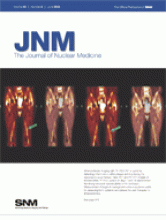TO THE EDITOR: The article by Soret et al. (1) in the June 2007 issue of The Journal of Nuclear Medicine on the implications of partial-volume effect (PVE) correction for PET in cancer provides a timely review of this important subject. It is quite clear that educating physicians—who are actively involved in the interpretation of PET images—is essential to correct for errors attributable to PVE. We congratulate the authors for their scholarly scientific communication and share our views on this topic in quantitative PET.
In recent years, a number of reports (1–3) have raised concerns about errors introduced by PVE in the quantitative assessment of tracer concentration with PET at intended sites. Although the initial reports dealt primarily with the measurement of metabolic values in the brain in different neurologic disorders (4–7), this effect has been increasingly recognized recently in malignant lesions (1–3,8–10). In addition to its importance in diagnosis, PVE correction has serious implications for treatment monitoring, an area in which a change in the standardized uptake value (SUV) is often used as an objective parameter to assess treatment response and in which lesions frequently become smaller after successful therapy. It is now proven that adoption of even a simple correction approach such as the recovery coefficient method can substantially reduce the error in uptake estimates of the lesions being examined.
The routine implementation of PVE correction in clinical practice is technically demanding and is an obstacle in most settings. By now, multiple clinical validation studies have addressed the importance of PVE correction and have suggested its use for accurate assessment of disease activity. However, successful implementation of this procedure would require a reproducible and relatively simple approach that can be performed on all patients.
Several PVE correction methods, including the popular recovery coefficient technique, require measuring the lesion dimensions in anatomic images such those produced by CT or MRI. The size estimate from current PET/CT scanners provides the opportunity to determine the PVE-corrected SUV readily. We believe the ever-increasing use of cross-sectional anatomic imaging with either CT or MRI along with the current-generation PET scanners can make this goal achievable through automated algorithms that provide the PVE-corrected SUV directly and easily. Until recently, the widespread use of PVE correction has been hampered primarily by the lack of integrated processing software with these hybrid scanners. With the use of fusion imaging in clinical practice becoming widespread, these limitations likely will not persist. We believe that manufacturers can assess the recovery coefficients for PVE correction for a particular scanner and integrate them into these scanners before they are installed at the site. The availability of a PVE-corrected SUV will be a strong step toward the routine use of this procedure at the clinical level, ultimately improving patient care. We speculate that eventually most scanners will have integrated automated PVE correction software. Both practitioners and the industry should be aware of the potential advantages of this evolution and take active steps toward bringing it about. Compared with the current schemes, integrated PVE software will strengthen the role and reliability of the SUV measurement as a quantitative measure.
In addition to the impact on routine patient care, such correction methods are expected to enhance the research applications of PET in the field of clinical oncology and other related disciplines. With PET/CT facilities being established in many centers across the world, it would be desirable for accurate clinical data to be generated not only from advanced and large university centers but also from small centers in communities with varying levels of expertise. The availability of integrated algorithms would likely improve reproducibility and reduce operator-dependent errors. Adoption of automated correction procedures that have been integrated with existing software will truly revolutionize the impact of this powerful modality worldwide. Every effort should be made toward achieving this goal.
Acknowledgments
This work was supported in part by the International Union against Cancer (UICC), Geneva, Switzerland, under the ACSBI fellowship.
Footnotes
-
COPYRIGHT © 2008 by the Society of Nuclear Medicine, Inc.







